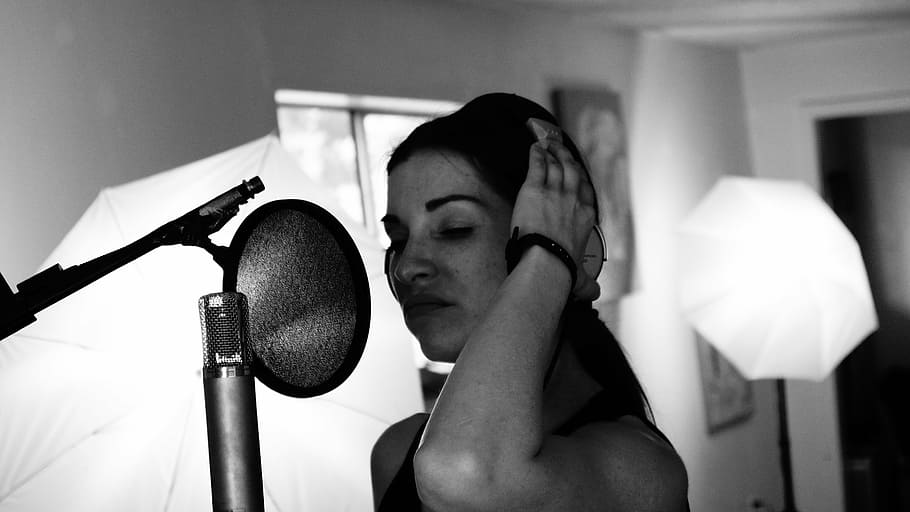(Alisa Apps Featured in Photo)
A pop filter is a simple mesh shield we place in front of a microphone. Typically made of nylon or metal, they clamp to a mic stand with an adjustable gooseneck.
For most close-miked vocal recording applications, they are a must. So why are pop filters so important?
What does a pop filter do?
A pop filter’s main purpose is to reduce the acoustic energy of plosive sounds in the human voice; these are primarily words that start with the letters ‘b’ or ‘p.’ This is similar, albeit slightly different to how a foam mic cover works.
We’ve all heard broadcast announcements that have a ton of loud clicking and banging noises in them. We don’t hear these things when speaking to each other, but a microphone greatly amplifies the noise.
The problem gets much more noticeable when the vocalist or speaker is close to the microphone. This is because the actual blast of plosive air is concentrated closest to the mouth itself. The air can hit a mic capsule so hard that it saturates it, or it can even clip the preamp. Obviously we want to avoid this in the studio, lest we ruin our vocal take.
Some microphones have a high-pass filter you can switch on or off. Since plosives are low-end material, this can be helpful. Still, though, we have the problem of actual physical air hitting the capsule.
To make matters worse, all directional microphones are susceptible to proximity effect. This is a bass build-up that occurs when the mic is very close to a sound source. You can see how this would further amplify plosives in the human voice.
Condenser microphones are especially prone to popping because of their light, sensitive diaphragms. Dynamic mics have a little more resistance because they tolerate high SPLs so well, but they definitely aren’t unaffected by plosives.
To help solve all these problems, engineers place a pop filter a few inches in front of their microphone capsule!
- RELATED: Recording Vocals in Your Home Studio
How does a pop filter work?
Honestly, there’s nothing fancy about a screen in front of a microphone! What does a pop filter do, then?
The way it works is very simple: the bulk of the sound travels through the mesh with no resistance. There can be some high-end loss, but it’s fairly inconsequential. Plosives, though, hit the screen and break up. The concentrated blast of air gets dispersed by the filter, reducing its impact on the microphone.
Lots of pop filter designs actually have two layers of mesh spaced an inch or so apart. Whatever passes through the first layer gets caught by the second, making them very effective for even the worst plosives.
Just don’t forget to place the filter at least a couple inches away from the microphone capsule itself. This ensures layers of protection — vocalist > pop filter > 2-3″ air gap > microphone.
Finally, pop filters can block saliva from ending up all over your microphone. Gross! Really, though, over years and years of use, saliva can actually corrode the internals of your mic. We definitely don’t want that!
Is high-frequency loss a concern?
Yes and no. Most engineers will probably tell you the highs absorbed by nylon pop filters hardly make a difference on the sound. If you are noticing problems with high-end attenuation using nylon filters, try using a metal one!
A metal pop filter has more widely spaced mesh. This lets the higher frequencies pass right through, but the holes are still small enough to break up plosives on impact.
Are pop filters necessary for good recordings?
You might think after all we’ve discussed the answer would be a resounding ‘yes.’ Realistically, though, it’s a ‘no.’ Though they’re helpful — and require basically zero effort apart from purchasing one — a pop filter isn’t 100% necessary for a quality recording, or even to reduce plosives.
You can minimize plosives through microphone technique, i.e., positioning the capsule slightly off-axis to the vocalist so he/she isn’t singing directly into it. (This helps reduce some sibilance too!) Experienced vocalists sometimes manage their own plosives by turning slightly away from the mic or backing off a few inches when singing loudly.
Lots of cool toys have made our lives much easier in the studio, but there’s still no replacement for knowledge, experience, and great mic technique!
Removing plosives while mixing (filter fails)
Pop filters aren’t perfect. If you’re editing and getting ready to mix your vocals, but the pop filter didn’t do its job on the way in, you aren’t out of luck.
Zoom in closely on the word where you hear the plosive. It should be right at the beginning — the very first letter of a ‘b,’ ‘p,’ or even ‘t’ word. Select the transient where the sound is most offensive. Now we want to print a high-pass filter right onto the plosive.
Some DAWs call this “selection-based processing” or something similar — Pro Tools calls it AudioSuite. With the plosive selected, pull up an EQ and set a high-pass to somewhere around 200 Hz for the most offensive plosives. Print it and listen back. Did that do the trick? If not, try setting the EQ to a higher frequency to minimize that low-end energy.
If you made the right clip selection, you should have transparently reduced the low-end on the plosive without hurting the rest of the word or phrase!
